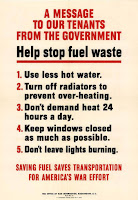Fuel Fights
 One of the hot issues 64 years ago was fuel rationing. It wasn't an issue of high energy prices as Americans tend to view it today, but one of scarcity of fuel due to its priority use in World War II.
One of the hot issues 64 years ago was fuel rationing. It wasn't an issue of high energy prices as Americans tend to view it today, but one of scarcity of fuel due to its priority use in World War II.
"During World War II many consumer goods were rationed for civilians in order to supply more goods for both American and Allied troops. Among the items rationed were sugar, red meat, gas, oil, coffee, and rubber. In October 1942 fuel oil was rationed. During the especially cold winter of 1942-43 this brought numerous protests from citizens. A temperature of 65 degrees was set as the standard for homes, by the federal government." (Source)
Both posters were originally published by the 
65 degrees is still a reasonable standard. If everyone used that benchmark, we probably wouldn't need fuel from the Mideast where we are now in a protracted war that has caused over 3200 American soldier deaths and 23,417 casulties.

1 comment:
"65 degrees is still a reasonable standard. If everyone used that benchmark, we probably wouldn't need fuel from the Mideast"
According to the Lawrence Livermore National Laboratory (a chart down currently for some reason), residential energy consumption only accounts for about 5% of our overall oil consumption (about 65% of which goes to transportation), so while such reductions would help, it doesn't seem to be nearly enough to eliminate our dependence on Mideast oil.
Post a Comment